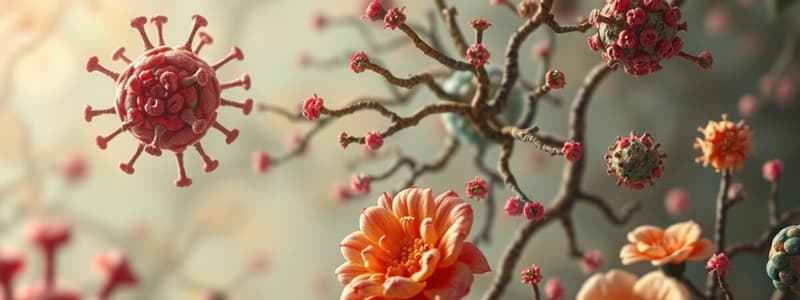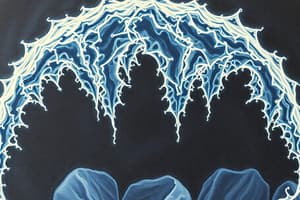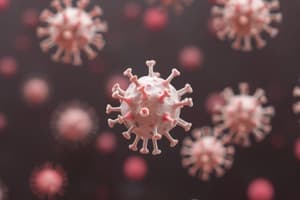Podcast
Questions and Answers
Which of the following is NOT a microorganism studied in microbiology?
Which of the following is NOT a microorganism studied in microbiology?
- Viruses
- Bacteria
- Fungi
- Insects (correct)
What is the study of bacteria called?
What is the study of bacteria called?
- Parasitology
- Virology
- Mycology
- Bacteriology (correct)
Which of the following microorganisms is eukaryotic?
Which of the following microorganisms is eukaryotic?
- Bacteria
- Archaea
- Fungi (correct)
- All of the above
What is the main function of the bacterial cell wall?
What is the main function of the bacterial cell wall?
How do bacteria typically multiply?
How do bacteria typically multiply?
Which phase of the microbial growth curve shows the highest rate of cell division?
Which phase of the microbial growth curve shows the highest rate of cell division?
What is the final electron acceptor in aerobic respiration?
What is the final electron acceptor in aerobic respiration?
What is the main function of mRNA?
What is the main function of mRNA?
What process eliminates all microorganisms, including spores?
What process eliminates all microorganisms, including spores?
What are antibiotics used for?
What are antibiotics used for?
What term describes the ability of a microorganism to cause disease?
What term describes the ability of a microorganism to cause disease?
What type of toxin is found in the outer membrane of Gram-negative bacteria?
What type of toxin is found in the outer membrane of Gram-negative bacteria?
Which of the following provides immediate, non-specific protection?
Which of the following provides immediate, non-specific protection?
What cells produce antibodies?
What cells produce antibodies?
What is the purpose of vaccines?
What is the purpose of vaccines?
Which type of microorganism causes malaria?
Which type of microorganism causes malaria?
What does environmental microbiology study?
What does environmental microbiology study?
What is bioremediation?
What is bioremediation?
What is the use of microorganisms in industrial processes called?
What is the use of microorganisms in industrial processes called?
What process is used to produce alcoholic beverages?
What process is used to produce alcoholic beverages?
Flashcards
What is Microbiology?
What is Microbiology?
The study of microorganisms, including bacteria, archaea, viruses, fungi, and protozoa, focusing on their structure, function, genetics, and behavior.
What is Bacteriology?
What is Bacteriology?
The branch of microbiology focused on the study of bacteria, including their identification, classification, and characteristics.
What is Virology?
What is Virology?
The branch of microbiology focused on the study of viruses, including their structure, genetics, and their role in causing diseases.
What is Mycology?
What is Mycology?
Signup and view all the flashcards
What is Parasitology?
What is Parasitology?
Signup and view all the flashcards
What is Immunology?
What is Immunology?
Signup and view all the flashcards
What are Prokaryotic Cells?
What are Prokaryotic Cells?
Signup and view all the flashcards
What are Eukaryotic Cells?
What are Eukaryotic Cells?
Signup and view all the flashcards
What is a Cell Wall?
What is a Cell Wall?
Signup and view all the flashcards
What is a Cell Membrane?
What is a Cell Membrane?
Signup and view all the flashcards
What are Plasmids?
What are Plasmids?
Signup and view all the flashcards
What is Binary Fission?
What is Binary Fission?
Signup and view all the flashcards
What is a Growth Curve?
What is a Growth Curve?
Signup and view all the flashcards
What is Culture Media?
What is Culture Media?
Signup and view all the flashcards
What is Fermentation?
What is Fermentation?
Signup and view all the flashcards
Transformation, Transduction, and Conjugation
Transformation, Transduction, and Conjugation
Signup and view all the flashcards
What is Sterilization?
What is Sterilization?
Signup and view all the flashcards
What is Disinfection?
What is Disinfection?
Signup and view all the flashcards
What is Pathogenicity?
What is Pathogenicity?
Signup and view all the flashcards
What is Virulence?
What is Virulence?
Signup and view all the flashcards
Study Notes
- Microbiology involves the study of microorganisms, including bacteria, archaea, viruses, fungi, and protozoa.
- These organisms are studied for their structure, function, genetics, and behavior.
- Microbiology has many applications in medicine, agriculture, industry, and environmental science.
Branches of Microbiology
- Bacteriology is the study of bacteria, including their identification, classification, and characteristics.
- Virology focuses on viruses, their structure, genetics, and their role in causing diseases
- Mycology involves the study of fungi, including yeasts, molds, and mushrooms.
- Parasitology is the study of parasites, including protozoa, helminths, and ectoparasites.
- Immunology studies the immune system and its response to pathogens.
Microbial Cell Structure
- Bacteria and archaea are prokaryotic, lacking a nucleus and other membrane-bound organelles
- Eukaryotic microorganisms, such as fungi, protozoa, and algae, possess a nucleus and other organelles
- Bacterial cell structures include the cell wall, cell membrane, cytoplasm, ribosomes, and genetic material (DNA).
- The cell wall provides shape and protection to the cell (e.g., peptidoglycan in bacteria).
- The cell membrane regulates the passage of substances in and out of the cell.
- Genetic material in bacteria is typically a single circular chromosome.
- Some bacteria possess plasmids, small circular DNA molecules that can carry antibiotic resistance genes
Microbial Growth
- Microorganisms require nutrients, water, and specific environmental conditions for growth.
- Factors affecting microbial growth include temperature, pH, oxygen availability, and nutrient availability.
- Bacteria multiply through binary fission, a process where one cell divides into two identical daughter cells.
- Microbial growth can be described by a growth curve; lag phase, exponential phase, stationary phase, and death phase.
- Culture media are used to grow microorganisms in the laboratory
Microbial Metabolism
- Microorganisms obtain energy through various metabolic processes, including respiration and fermentation.
- Aerobic respiration uses oxygen as the final electron acceptor, while anaerobic respiration uses other substances.
- Fermentation is an anaerobic process that produces ATP and various end products, such as ethanol or lactic acid.
- Microorganisms can be classified based on their carbon and energy sources; autotrophs and heterotrophs.
Microbial Genetics
- DNA is the genetic material in most microorganisms, encoding all the information necessary for cell function
- RNA plays a role in protein synthesis, including mRNA, tRNA, and rRNA
- Mutations can occur spontaneously or be induced by mutagens, leading to changes in the DNA sequence.
- Genetic material can be transferred between microorganisms through transformation, transduction, and conjugation.
Control of Microorganisms
- Sterilization eliminates all microorganisms, including bacteria, viruses, fungi, and spores.
- Disinfection reduces the number of microorganisms to a safe level.
- Physical methods of control include heat, filtration, and radiation.
- Chemical methods of control involve the use of disinfectants, antiseptics, and antibiotics.
- Antibiotics are used to treat bacterial infections by inhibiting bacterial growth or killing bacteria.
Microbial Pathogenicity
- Pathogenicity is the ability of a microorganism to cause disease.
- Virulence refers to the degree of pathogenicity
- Pathogens can cause disease through various mechanisms, including toxin production, tissue invasion, and immune response.
- Some bacteria produce exotoxins, which are secreted toxins that can damage host cells
- Endotoxins are lipopolysaccharides (LPS) found in the outer membrane of Gram-negative bacteria.
- Pathogens can be transmitted through various routes, including air, water, food, and direct contact.
Immunology
- The immune system protects the host from pathogens and other harmful substances.
- Innate immunity provides immediate, non-specific protection, including physical barriers, phagocytes, and complement.
- Adaptive immunity is a specific response that develops over time, involving lymphocytes (B cells and T cells)
- Antibodies are produced by B cells to neutralize pathogens or mark them for destruction.
- T cells mediate cellular immunity, including helper T cells and cytotoxic T cells.
- Vaccines are used to induce immunity to specific pathogens, preventing disease.
Medical Microbiology
- Medical microbiology focuses on the role of microorganisms in causing diseases in humans.
- Bacteria can cause a wide range of infections, including pneumonia, urinary tract infections, and skin infections.
- Viruses can cause diseases such as influenza, measles, and HIV/AIDS.
- Fungi can cause infections such as athlete's foot, ringworm, and systemic mycoses.
- Protozoa and helminths can cause parasitic infections, such as malaria and tapeworm infections.
- Diagnostic microbiology involves the identification of microorganisms in clinical samples.
Environmental Microbiology
- Environmental microbiology studies the role of microorganisms in the environment, including soil, water, and air.
- Microorganisms play a role in nutrient cycling, decomposition, and bioremediation.
- Bioremediation uses microorganisms to clean up pollutants and contaminants in the environment.
- Microorganisms can be used to treat wastewater and produce biofuels.
Industrial Microbiology
- Industrial microbiology involves the use of microorganisms in industrial processes.
- Microorganisms can be used to produce antibiotics, enzymes, and other valuable products.
- Fermentation processes are used to produce alcoholic beverages, foods, and pharmaceuticals.
- Genetic engineering can be used to modify microorganisms for specific industrial applications.
Studying That Suits You
Use AI to generate personalized quizzes and flashcards to suit your learning preferences.




